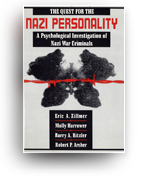 |

Open to Interpretation…The Art and Science of Inkblots
Ashland, OH: Hogrefe, 2009
[more]
............................................
Principles of Neuropsychology
Belmont, CA: Wadsworth, 2008
[more]
............................................
Military Psychology: Clinical and Operational Applications
New York, NY: Guilford, 2006
[more]
............................................
The Quest for
the Nazi Personality
Hillsdale, NJ: Lawrence Erlbaum Associates, 1995
............................................
Neuropsychological Assessment and Intervention
Springfield, IL: Charles Thomas, 1992
[more]
|
 |
|
 |
 |
 |
THE QUEST FOR THE NAZI PERSONALITY:
A Psychological Investigation of Nazi War Criminals

Eric A. Zillmer, Molly Harrower, Barry A. Ritzler, & Robert P. Archer
Hillsdale, NJ: Lawrence Erlbaum Associates, 1995
|

BATS AND DANCING BEARS.
An Interview with Eric Zillmer
With Sina Najafi, Editor, Cabinet Magazine (Issue 5, Winter 2001)
The Rorschach test is the most famous example of pareidolia, the technical term for our ability to find specific images among random patterns. Inkblots did not begin with Hermann Rorschach (1884-1922), however. Leonardo da Vinci, Botticelli, and Victor Hugo were precursors in the arts. In 1857, Justinus Kerner had published Kleksographien, a book of inkblot-inspired poems, and Alfred Binet was one of many psychologists at the turn of the century who had previously investigated the phenomenon as a useful psychological test.
Once the most commonly used psychological personality test, the Rorschach has now been eclipsed by shorter and more convenient testing methods. Despite this, it is still widely used in forensic contexts, Ted Bundy and Theodore Kaczynski being two famous recent test-takers. The most spectacular and controversial tests, however, were those administered to Nazis placed on trial after World War II. Considered an invaluable source for understanding the relationship, if any, between pathology and the emergence of Nazism, the tests were nevertheless not collated until the 1995 publication of Eric Zillmer's The Quest for the Nazi Personality. Eric Zillmer is currently the Carl R. Pacifico Professor of Neuropsychology at Drexel University in Philadelphia. Sina Najafi spoke to him by phone.
First Question...
|
|